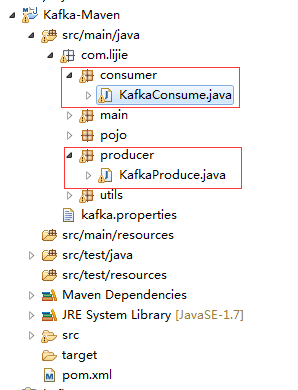小编给大家分享一下kafka生产者和消费者的javaAPI怎么用,相信大部分人都还不怎么了解,因此分享这篇文章给大家参考一下,希望大家阅读完这篇文章后大有收获,下面让我们一起去了解一下吧!
写了个kafka的java demo 顺便记录下,仅供参考
1.创建maven项目
目录如下:

2.pom文件:
<project xmlns="http://maven.apache.org/POM/4.0.0" xmlns:xsi="http://www.w3.org/2001/XMLSchema-instance"
xsi:schemaLocation="http://maven.apache.org/POM/4.0.0 http://maven.apache.org/xsd/maven-4.0.0.xsd">
<modelVersion>4.0.0</modelVersion>
<groupId>Kafka-Maven</groupId>
<artifactId>Kafka-Maven</artifactId>
<version>0.0.1-SNAPSHOT</version>
<dependencies>
<dependency>
<groupId>org.apache.kafka</groupId>
<artifactId>kafka_2.11</artifactId>
<version>0.10.1.1</version>
</dependency>
<dependency>
<groupId>org.apache.hadoop</groupId>
<artifactId>hadoop-common</artifactId>
<version>2.2.0</version>
</dependency>
<dependency>
<groupId>org.apache.hadoop</groupId>
<artifactId>hadoop-hdfs</artifactId>
<version>2.2.0</version>
</dependency>
<dependency>
<groupId>org.apache.hadoop</groupId>
<artifactId>hadoop-client</artifactId>
<version>2.2.0</version>
</dependency>
<dependency>
<groupId>org.apache.hbase</groupId>
<artifactId>hbase-client</artifactId>
<version>1.0.3</version>
</dependency>
<dependency>
<groupId>org.apache.hbase</groupId>
<artifactId>hbase-server</artifactId>
<version>1.0.3</version>
</dependency>
<dependency>
<groupId>org.apache.hadoop</groupId>
<artifactId>hadoop-hdfs</artifactId>
<version>2.2.0</version>
</dependency>
<dependency>
<groupId>jdk.tools</groupId>
<artifactId>jdk.tools</artifactId>
<version>1.7</version>
<scope>system</scope>
<systemPath>${JAVA_HOME}/lib/tools.jar</systemPath>
</dependency>
<dependency>
<groupId>org.apache.httpcomponents</groupId>
<artifactId>httpclient</artifactId>
<version>4.3.6</version>
</dependency>
</dependencies>
<build>
<plugins>
<plugin>
<groupId>org.apache.maven.plugins</groupId>
<artifactId>maven-compiler-plugin</artifactId>
<configuration>
<source>1.7</source>
<target>1.7</target>
</configuration>
</plugin>
</plugins>
</build>
</project>3.kafka生产者KafkaProduce:
package com.lijie.producer;
import java.io.File;
import java.io.FileInputStream;
import java.util.Properties;
import org.apache.kafka.clients.producer.Callback;
import org.apache.kafka.clients.producer.KafkaProducer;
import org.apache.kafka.clients.producer.ProducerRecord;
import org.apache.kafka.clients.producer.RecordMetadata;
import org.slf4j.Logger;
import org.slf4j.LoggerFactory;
public class KafkaProduce {
private static Properties properties;
static {
properties = new Properties();
String path = KafkaProducer.class.getResource("/").getFile().toString()
+ "kafka.properties";
try {
FileInputStream fis = new FileInputStream(new File(path));
properties.load(fis);
} catch (Exception e) {
e.printStackTrace();
}
}
/**
* 发送消息
*
* @param topic
* @param key
* @param value
*/
public void sendMsg(String topic, byte[] key, byte[] value) {
// 实例化produce
KafkaProducer<byte[], byte[]> kp = new KafkaProducer<byte[], byte[]>(
properties);
// 消息封装
ProducerRecord<byte[], byte[]> pr = new ProducerRecord<byte[], byte[]>(
topic, key, value);
// 发送数据
kp.send(pr, new Callback() {
// 回调函数
@Override
public void onCompletion(RecordMetadata metadata,
Exception exception) {
if (null != exception) {
System.out.println("记录的offset在:" + metadata.offset());
System.out.println(exception.getMessage() + exception);
}
}
});
// 关闭produce
kp.close();
}
}4.kafka消费者KafkaConsume:
package com.lijie.consumer;
import java.io.File;
import java.io.FileInputStream;
import java.util.HashMap;
import java.util.List;
import java.util.Map;
import java.util.Properties;
import org.apache.htrace.fasterxml.jackson.databind.ObjectMapper;
import com.lijie.pojo.User;
import com.lijie.utils.JsonUtils;
import kafka.consumer.ConsumerConfig;
import kafka.consumer.ConsumerIterator;
import kafka.consumer.KafkaStream;
import kafka.javaapi.consumer.ConsumerConnector;
import kafka.serializer.StringDecoder;
import kafka.utils.VerifiableProperties;
public class KafkaConsume {
private final static String TOPIC = "lijietest";
private static Properties properties;
static {
properties = new Properties();
String path = KafkaConsume.class.getResource("/").getFile().toString()
+ "kafka.properties";
try {
FileInputStream fis = new FileInputStream(new File(path));
properties.load(fis);
} catch (Exception e) {
e.printStackTrace();
}
}
/**
* 获取消息
*
* @throws Exception
*/
public void getMsg() throws Exception {
ConsumerConfig config = new ConsumerConfig(properties);
ConsumerConnector consumer = kafka.consumer.Consumer
.createJavaConsumerConnector(config);
Map<String, Integer> topicCountMap = new HashMap<String, Integer>();
topicCountMap.put(TOPIC, new Integer(1));
StringDecoder keyDecoder = new StringDecoder(new VerifiableProperties());
StringDecoder valueDecoder = new StringDecoder(
new VerifiableProperties());
Map<String, List<KafkaStream<String, String>>> consumerMap = consumer
.createMessageStreams(topicCountMap, keyDecoder, valueDecoder);
KafkaStream<String, String> stream = consumerMap.get(TOPIC).get(0);
ConsumerIterator<String, String> it = stream.iterator();
while (it.hasNext()) {
String json = it.next().message();
User user = (User) JsonUtils.JsonToObj(json, User.class);
System.out.println(user);
}
}
}5.kafka.properties文件
##produce
bootstrap.servers=192.168.80.123:9092
producer.type=sync
request.required.acks=1
serializer.class=kafka.serializer.DefaultEncoder
key.serializer=org.apache.kafka.common.serialization.ByteArraySerializer
value.serializer=org.apache.kafka.common.serialization.ByteArraySerializer
bak.partitioner.class=kafka.producer.DefaultPartitioner
bak.key.serializer=org.apache.kafka.common.serialization.StringSerializer
bak.value.serializer=org.apache.kafka.common.serialization.StringSerializer
##consume
zookeeper.connect=192.168.80.123:2181
group.id=lijiegroup
zookeeper.session.timeout.ms=4000
zookeeper.sync.time.ms=200
auto.commit.interval.ms=1000
auto.offset.reset=smallest
serializer.class=kafka.serializer.StringEncoder以上是“kafka生产者和消费者的javaAPI怎么用”这篇文章的所有内容,感谢各位的阅读!相信大家都有了一定的了解,希望分享的内容对大家有所帮助,如果还想学习更多知识,欢迎关注亿速云行业资讯频道!
亿速云「云服务器」,即开即用、新一代英特尔至强铂金CPU、三副本存储NVMe SSD云盘,价格低至29元/月。点击查看>>
免责声明:本站发布的内容(图片、视频和文字)以原创、转载和分享为主,文章观点不代表本网站立场,如果涉及侵权请联系站长邮箱:is@yisu.com进行举报,并提供相关证据,一经查实,将立刻删除涉嫌侵权内容。